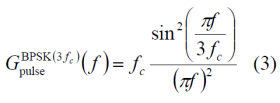If you wish to contribute or participate in the discussions about articles you are invited to contact the Editor
Generic BCS Signals: Difference between revisions
Carlos.Lopez (talk | contribs) (Created page with "{{Article Infobox2 |Category=Fundamentals |Title={{PAGENAME}} |Authors= J.A Ávila Rodríguez, University FAF Munich, Germany. |Level=Advanced |YearOfPublication=2011 }} In the p...") |
Carlos.Lopez (talk | contribs) No edit summary |
||
| Line 1: | Line 1: | ||
{{Article Infobox2 | {{Article Infobox2 | ||
|Category=Fundamentals | |Category=Fundamentals | ||
|Authors=J.A Ávila Rodríguez, University FAF Munich, Germany. | |||
|Authors= J.A Ávila Rodríguez, University FAF Munich, Germany. | |||
|Level=Advanced | |Level=Advanced | ||
|YearOfPublication=2011 | |YearOfPublication=2011 | ||
|Title={{PAGENAME}} | |||
}} | }} | ||
Two particular cases of the [[Binary Coded Symbols (BCS)|BCS modulation]] are the [[Binary Phase Shift Keying Modulation (BPSK) |BPSK]] and [[Binary Offset Carrier (BOC)|BOC]] modulations. Nonetheless, we show in the next lines how the [[Autocorrelation & Power Spectral Density|Power Spectral Density (PSD)]] of a generic BCS could be derived. | |||
Let us assume a BCS signal with vector s = [+1, +1, -1]. We have thus <math>s_1 = +1 , s_2 = +1 , s_3 = -1</math>. The modulating term of the PSD can be easily calculated as: | Let us assume a BCS signal with vector s = [+1, +1, -1]. We have thus <math>s_1 = +1 , s_2 = +1 , s_3 = -1</math>. The modulating term of the PSD can be easily calculated as: | ||
| Line 28: | Line 28: | ||
In general, in order to understand how the spectrum will look like for a given sequence, we have to be able to understand how every term of the sum above contributes to the total PSD. | In general, in order to understand how the spectrum will look like for a given sequence, we have to be able to understand how every term of the sum above contributes to the total PSD. | ||
[[Category:Fundamentals]] | [[Category:Fundamentals]] | ||
[[Category:GNSS Signals]] | [[Category:GNSS Signals]] | ||
Revision as of 11:18, 18 November 2011
| Fundamentals | |
|---|---|
| Title | Generic BCS Signals |
| Author(s) | J.A Ávila Rodríguez, University FAF Munich, Germany. |
| Level | Advanced |
| Year of Publication | 2011 |
Two particular cases of the BCS modulation are the BPSK and BOC modulations. Nonetheless, we show in the next lines how the Power Spectral Density (PSD) of a generic BCS could be derived.
Let us assume a BCS signal with vector s = [+1, +1, -1]. We have thus [math]\displaystyle{ s_1 = +1 , s_2 = +1 , s_3 = -1 }[/math]. The modulating term of the PSD can be easily calculated as:
which can be further simplified to:
while
Thus the spectrum of this BCS sequence would adopt the following form:
In general, in order to understand how the spectrum will look like for a given sequence, we have to be able to understand how every term of the sum above contributes to the total PSD.




